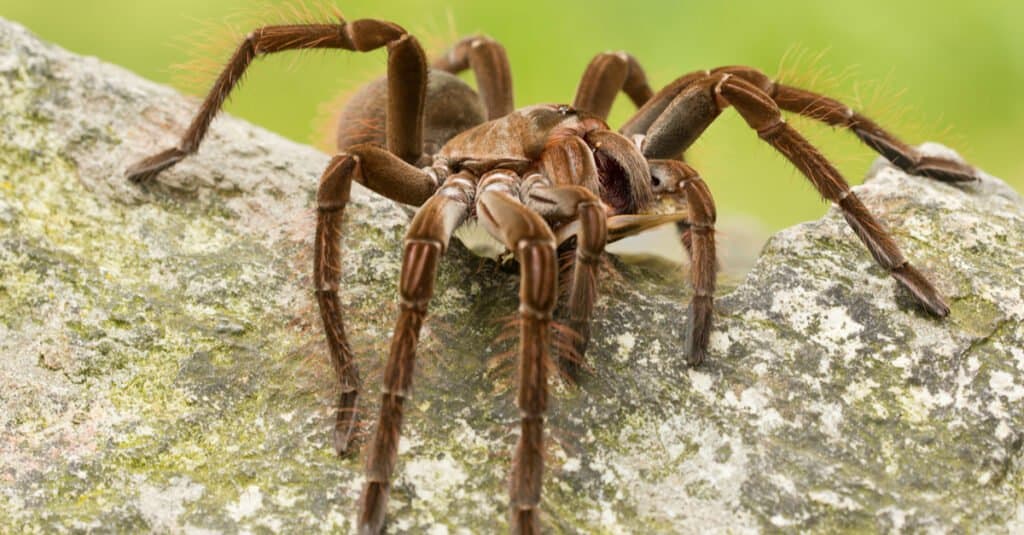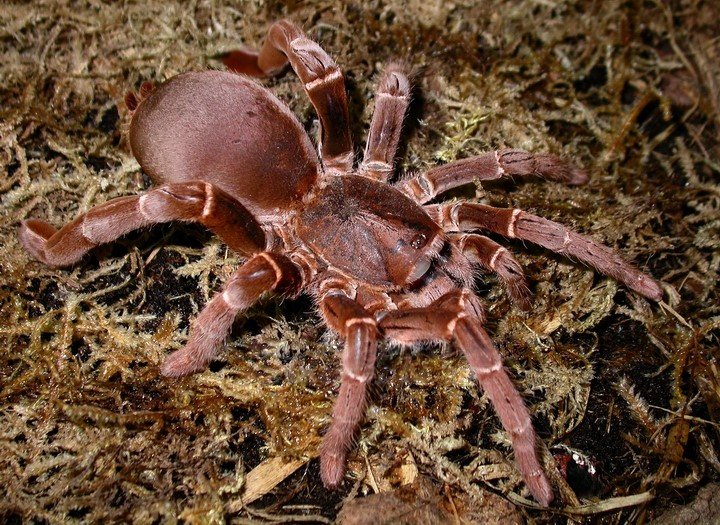It is easy to grimace whenever you see a tarantula. Their hairy bodies and long legs sure are enough to give you the creeps. Given their monstrous appearance and fierce reputation embodied in stories and films, we can’t help but wonder, are tarantulas poisonous or dangerous? If you take one look at a tarantula, it is easy to assume that they are dangerous, but observing how other people handle tarantulas as pets, you might start to think otherwise. The truth is, despite their terrifying facade, these creepy crawlies are harmless to humans. While tarantulas possess venom, their bite delivers only mild venom that is too weak to affect humans. But still, never provoke a tarantula because their bite can be extremely painful.
Tarantula Bites

A tarantula’s bite can be very painful.
©Milan Zygmunt/Shutterstock.com
Generally, the tarantula is not an aggressive spider. They are known to be pets and are even docile when handled gently and well cared for. But when provoked or threatened, a tarantula can bite in self-defense, which can be very painful. However, tarantulas are collectively classified into two groups: the New World and the Old World tarantulas. The Old World tarantulas are way more venomous and are only allowed to be kept as pets by experts.
New World tarantulas are commonly venomous, but their venom is not strong enough to harm humans. A common tarantula’s bite feels similar to a bee sting. It often leaves the bite site reddish and warm. You may also notice puncture marks in the wound that causes even more pain. The sting somehow feels like throbbing that will last for a few hours, but if you develop other symptoms a few hours after the bite, you must seek further medical attention. Tarantula bites should have mild effects, and if other symptoms surface, it may be an allergic reaction to their venom.
In contrast to this, the Old World tarantulas have venom that is far stronger than the New World species. In fact, a human bitten by an Old World tarantula may experience muscle spasms, cramps, and possibly pass out unless prompt antivenom administration is given.
Are Tarantulas Dangerous To Humans?

Tarantula venom is primarily used in paralyzing and killing prey.
©Milan Zygmunt/Shutterstock.com
The answer depends on the species or group of tarantulas. Apart from their intensely painful bite, New World tarantulas are not dangerous to humans; we still need to be careful nonetheless. The venom delivered by most tarantulas when they bite is mild, even weaker than a bee’s venom. It is primarily used in paralyzing and killing their prey and is not fully effective on humans. The most that New World tarantulas can do to humans is puncture the skin, leaving a mild yet painful and itchy bite wound and causing some allergic reactions in some cases.
The Old World tarantula venom is more potent than its New World counterpart. Unfortunately, there is currently no reliable scientific data on the potency of Old World tarantula venom or the potential effects of different species’ venom on humans. However, bite reports from around the world frequently describe bites as being much more painful to endure and have additional side effects.
Baboon spider bites, for instance, are known to burn ferociously when first bitten but then gradually subside. However, days after being bitten, victims have described experiencing sudden, intense cramping in various body regions that left them writhing in agony on the floor and unable to walk or move easily. Bites from Poecilotheria species have been described as burning like one’s arm has been plunged in hot oil and causing blisters on the skin near the bite site.
Not only species from the Old World possess a powerful venom, though. Some species from the New World, like the Psalmopoeus species, are also venomous and should not be handled by inexperienced hobbyists.
Tarantulas only bite when they are provoked or handled harshly, but since most species’ venom is weak, they only leave red, swollen bite marks, wherein swelling and itching last only for a few hours. On the other hand, their hairs have barbs that can cut through the skin but only leave itchy bumps for days. However, some people may have allergic reactions to their venom, which can sometimes cause more severe effects. An allergic reaction to a tarantula’s venom shows difficulty breathing, eyelid puffiness, itchiness, increased heart rate, skin rash, and swelling of the lips or throat. Some people may exhibit more intense reactions such as low blood pressure and loss of blood flow to major organs.
There are no known antidotes for tarantula bites, but over-the-counter pain relievers and cold compress can somehow lessen the pain. Once bitten, the wound must immediately be washed by warm soap and water, while flicked hairs can be removed through patching and gently peeling off sticky tapes. Over-the-counter ointments can subdue skin irritations caused by the strands.
What Types of Tarantulas Are Poisonous?

Old World tarantulas, like the Baboon spider, have venom capable of affecting humans.
©Www.universoaracnido.com / CC BY-SA 2.5 – License
There are over 850 species of tarantulas, and all of them are venomous, yet the most potent venom belongs to those from the Old World. Old World Tarantulas are much less docile and more likely to try to bite an enemy (including humans) if provoked, especially those native to Asia. Numerous anecdotal accounts from those who deal with tarantula pets describe severe bites that occasionally require hospitalization. Localized pain and swelling, tiredness, mild to severe muscle cramps, labored breathing, and fever are some symptoms that might appear days or even weeks after the first bite. Species of Old World tarantulas include the Baboon spider, Chinese bird spider, and Cobalt blue spider.
How To Avoid Tarantula Bites
Tarantulas rarely bite, especially when they are kept as pets. It is safe for expert pet handlers to pick up and handle tarantulas as these spiders are docile and timid. However, tarantulas may get startled or provoked when held roughly or cornered, leading them to bite. To keep tarantulas from biting, you should handle them very gently. Wear gloves and eye protection to avoid contact with spiky hairs.
Other Dangers of Tarantulas
The tarantula’s bite is not the only thing you should be wary of, as contact with the tarantula’s hairs poses a far greater risk than getting bitten. When tarantulas become threatened or provoked, they rub their back legs across their bodies to whisk thousands of hairs from their bodies towards their adversary, including humans. Apart from their bite and venom, tarantulas use this strategy as a form of self-defense.
These hairs may look soft and silky from afar, but they have spikes that can pierce through human skin. As the hairs cut through the skin, they can result in inflammation such as redness, swelling, pain, and itchiness that lasts for weeks. Tarantula hairs can also get to the eyes when flicked, which can cause severe pain, sensitivity to light, redness, and other optical problems. Having tarantula hairs inside the eyes feels like shards of glass spread throughout. This discomfort can last for weeks, as the tarantula hairs can stay inside the eyes for quite some time.
The photo featured at the top of this post is © iStock.com/Dan Olsen
Sources
- Animal Corner, Available here: https://animalcorner.org/animals/old-world-tarantula-spiders/
- , Available here: https://www.mymonsters.co.za/knowledge-base/old-world-tarantulas/
Thank you for reading! Have some feedback for us? Contact the AZ Animals editorial team.






